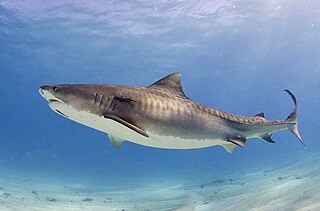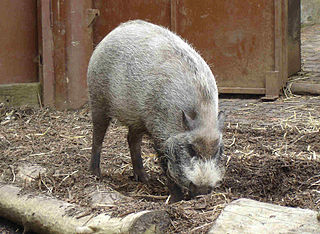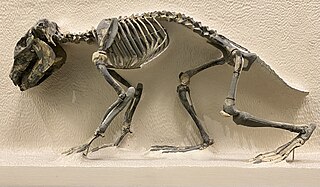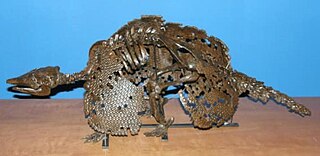
Galeocerdo is a genus of ground shark. Only a single species, G. cuvier, the tiger shark is extant. The earliest fossils date back to the early Eocene epoch, (Ypresian), around 56–47.8 Million years ago. While historically considered a member of the requiem shark family Carcharhinidae, it is currently considered to be the only member of the family Galeocerdonidae. While this genus was historically considered diverse, including 21 extinct species, morphometric analysis conducted in 2021 suggested that the diversity of the genus included only 5 extinct species much lower than previously assumed. The oldest fossils of the extant G. cuvier date to the middle Miocene.

Balaenoptera is a genus of rorquals containing eight extant species. Balaenoptera comprises all but two of the extant species in its family ; the genus is currently polyphyletic, with the two aforementioned species being phylogenetically nested within it.

Hydrodamalinae is a recently extinct subfamily of the sirenian family Dugongidae. The Steller's sea cow was hunted to extinction by 1768, while the genus Dusisiren is known from fossils dating from the middle Miocene to early Pliocene.

Cyclanorbis is a genus of softshell turtles in the family Trionychidae. The genus is endemic to Africa.

Cycloderma is a genus of softshell turtles in the subfamily Cyclanorbinae of the family Trionychidae. The genus is endemic to Africa.

Suinae is a subfamily of artiodactyl mammals that includes several of the extant members of Suidae and their closest relatives – the domestic pig and related species, such as babirusas. Several extinct species within the Suidae are classified in subfamilies other than Suinae. However, the classification of the extinct members of the Suoidea – the larger group that includes the Suidae, the peccary family (Tayassuidae), and related extinct species – is controversial, and different classifications vary in the number of subfamilies within Suidae and their contents. Some classifications, such as the one proposed by paleontologist Jan van der Made in 2010, even exclude from Suinae some extant taxa of Suidae, placing these excluded taxa in other subfamilies.

Hegetotheriidae is an extinct family of notoungulate mammals known from the Oligocene through the Pliocene of South America.

Euryzygoma is an extinct genus of marsupial which inhabited humid eucalyptus forests in Queensland and New South Wales during the Pliocene of Australia. Euryzygoma is believed to have weighed around 500 kg, and differed from other diprotodonts in having unusual, flaring cheekbones that may have been used either for storing food or for sexual display. Euryzygoma is thought to be the ancestral genus from which Diprotodon evolved.

Pachyarmatherium is a genus of extinct large armadillo-like cingulates found in North and South America from the Pliocene and Pleistocene epochs, related to the extant armadillos and the extinct pampatheres and glyptodonts. It was present from 4.9 Mya to 11,000 years ago, existing for approximately 4.889 million years.

Pangshura is a genus of geoemydid turtles endemic to South Asia. Its member species were formerly in the obsolete genus Kachuga. A fifth member, Pangshura tatrotia, was described in 2010, but it is only known from Pliocene fossils.

Cetotheriidae is a family of baleen whales. The family is known to have existed from the Late Oligocene to the Early Pleistocene before going extinct. Although some phylogenetic studies conducted by Fordyce & Marx 2013 recovered the living pygmy right whale as a member of Cetotheriidae, making the pygmy right whale the only living cetotheriid, other authors either dispute this placement or recover Neobalaenidae as a sister group to Cetotheriidae.

Eschrichtioides is an extinct genus of baleen whale known from the early Pliocene of northern Italy. Its type species, E. gastaldii, had a complex taxonomic history, starting as a cetothere, then as an extinct member of Balaenoptera, before being finally recognized as a relative of the gray whale.
The Juchipila Formation is a geologic formation in Mexico. It preserves fossils dating back to the Neogene period. Closely corresponding to the other Hemphillian faunal assemblages of North America, it is significant for understanding the palaeofauna of Miocene and Pliocene central Mexico.

The Pisco Formation is a geologic formation located in Peru, on the southern coastal desert of Ica and Arequipa. The approximately 640 metres (2,100 ft) thick formation was deposited in the Pisco Basin, spanning an age from the Late Miocene up to the Early Pliocene, roughly from 9.6 to 4.5 Ma. The tuffaceous sandstones, diatomaceous siltstones, conglomerates and dolomites were deposited in a lagoonal to near-shore environment, in bays similar to other Pacific South American formations as the Bahía Inglesa and Coquimbo Formations of Chile.
Hypsitherium is an extinct genus of Mesotheriidae that lived 4.0 to 3 million years ago. It is known from the Miocene to Pliocene Inchasi fossil locality in Bolivia. Hypsitherium was a scansorial herbivore, and its name translates to "high beast."
Sivahyus was a genus of ground dwelling omnivorous even toed ungulates that existed in Asia during the Pliocene.
Cainochoerinae was a subfamily of even-toed ungulates that existed during the Miocene and Pliocene in Asia and Africa.

Hyotheriinae was a subfamily of even-toed ungulates that existed during the Miocene and Pliocene in Europe, Asia, and Africa.
Potamochoeroides was an extinct genus of even-toed ungulates that existed during the Pliocene in South Africa.
Kamtschatarctos is an extinct genus of pinniped that lived approximately 15.97 to 11.608 mya during the Early Miocene in the Kavran-Ukhtolok Bay of Russia's Kamchatka Peninsula. It belonged to the family Odobenidae, the only extant species of which is the walrus.














